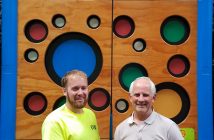For the past few years, the popularity of rock climbing has grown wildly, and that growth shows no signs of slowing down. In the past year we’ve seen rock climbing join the ranks of Olympic sports, and even win an Oscar. According to Climbing Business Journal’s 2018 Gyms and Trends report, the climbing gym industry had its most successful year ever in 2018, with 50 new commercial gyms opening in the U.S.—growth of nearly 12 percent.
While the report only takes into account commercial rock climbing gyms and doesn’t include other applications such as climbing walls and elements in other settings, it reflects the increasing popularity of the sport—and adventure park operators are paying attention.
Why Build a Wall?
Rock climbing is among the most popular “adventure” activities in the public imagination at a time when people increasingly seek experiences over material possessions. The popularity of climbing walls in particular is due to their accessibility—the very young to the very experienced can enjoy an exciting and gratifying adventure activity. That makes it an effective addition to adventure parks that aim to welcome more multi-generational families.
“Climbing is something that I think the public understands,” says Carson Rivers, vice president at High Gravity Adventures in Blowing Rock, N.C. “People who aren’t in the industry don’t really understand the term ‘aerial adventure park.’ From a marketing perspective, climbing and zip lines are things the public understands.”
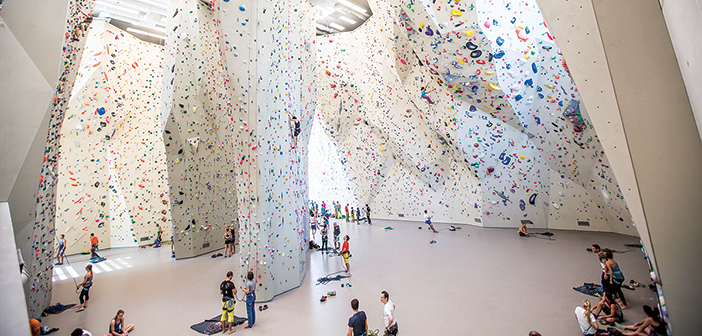
The elaborate indoor Klettercentrum in Innsbruck, Austria, built by Walltopia.
But integrating a climbing wall into an adventure park comes with various considerations, including format, design, costs, staffing, and operations, as well as how to most effectively fit one into the overall guest experience.
Who will it serve? The first, and broadest, question operators should consider is: what purpose will a climbing element serve in my park? Answering this will help address a number of future concerns and inform decisions around building the element.
For example, do you need a climbing wall to help attract additional customers who might not be able to use a traditional zip line or ropes course, or to add off-season activities? Aspen Snowmass, Colo., checked both those boxes when it included the Rugged Ascent climbing wall in its Lost Forest Mountain Adventure Center, which also features a mountain coaster, multi-level challenge course, zip line canopy tour, and more.
“We wanted to have something for the smaller kids to be able to do,” says Dave Gray, director of guest services at Snowmass. “With climbing walls, there’s a lower weight limit and lower height limits, so any kid who can walk and meet those limits can do it.” In addition, climbing is a more family-friendly, less risky summer activity, so it broadens the market of paying customers.
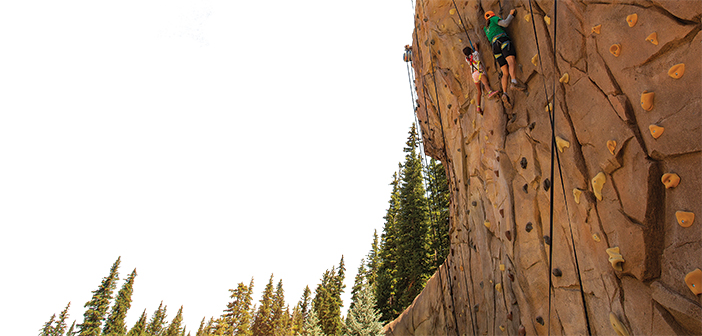
Eldorado Climbing Walls built the Rugged Ascent outdoor climbing wall at Snowmass, Colo.
Package pricing. Such separate climbing features allow parks to sell climbing walls differently than other activities, with various packages available based on the experiences the guests want to have. “People can just go from one [activity]to another, and we sell it as a package deal,” says Gray. “So people can buy the basic experience, which includes the climbing wall and the mountain coaster. Most of the families with smaller kids do this because they’re too small to go on the challenge course.”
Where to Build a Wall?
Sometimes there are more rules to consider when adding a climbing wall. According to Christina Frain, director of marketing at Eldorado Climbing Walls, “Forest Service regulation is a big concern” for parks on the national forest. Those rules say that climbing walls should integrate aesthetically into the surrounding landscape. Natural-looking climbing walls fit that bill, and a reputable climbing wall builder can educate operators around these considerations.
That’s why Eldorado sees many more full walls being built at ski areas: “First, they’re a logical adventure feature. And second, on property leased from the Forest Service, they need activities that look like they belong, so a realistic rock climbing structure [like the one at Aspen Snowmass]works well within those parameters.”
A climbing wall can serve as an added attraction during busy days, too. “Climbing walls frequently serve as a holding pen, as well as a destination feature with high throughput,” Frain says. “While waiting for lower-throughput ropes courses, for example, [climbing]is something quick that individuals can do.”
Walls vs. stairs. Other parks use climbing as an “instance” activity. This type of climbing integration serves a more specific end, such as a multi-level aerial adventure park that needs to take guests economically—financially and time-wise—from one level to another.

Walltopia-built Sender One climbing facility.
Climbing walls may serve an important purpose for permitting as well, since stairs must meet more rigorous international standards that can boost the cost of building the entire park. “If you’re putting in a stair system to access a course, that’s typically going to be more expensive than putting together a small, simple wall to elevate a short distance like that,” Rivers says. “Sometimes having something that is another challenge element vs. a more recognizable set of stairs might also simplify some of your inspections.”
Go Big or Go Small
Some parks want to create totally unique experiences, and climbing walls can play a role in that. Ivaylo Sotirov, CEO of climbing wall manufacturer Walltopia USA, asks his clients first what kind of experience they want their guests to have on a Walltopia wall. “Some will say they want a climbing wall for six people at a time, which is a simple cookie-cutter wall,” Sotirov says.
But other clients want to translate a sense of adventure to their climbing structures, and this has become a new trend in climbing, according to Sotirov. “Clients will say: ‘I love the Grand Canyon. I love the adventure, the hiking, and want to bring that indoor to my facility,’” he says. “So when we talk to them, we want to work with those unique situations.”
Understanding costs. But, of course, it eventually comes down to cost. “We’ll get plenty of people that call and say, ‘budget’s not everything.’ But by the end of the day, we discover it’s kind of everything,” says Rivers. When it comes down to it, operators need to make money. So they want to know what it will cost to build, maintain, and staff climbing elements, as well as how long it will take to recoup the costs through in-season operation.
Multiple factors contribute to the cost of installing a climbing element. What materials were chosen for construction of the wall? Is the location convenient for transporting materials—say, at ground level for a ropes course, versus at the top of a chairlift?
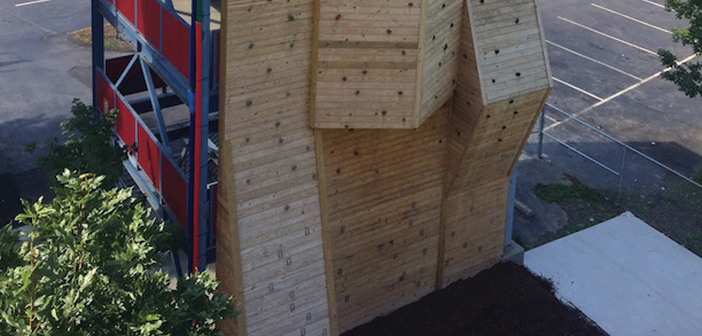
Creative wall by Challenge Towers.
For material, a Walltopia wall starts at about $178 per square meter, plus transportation and construction that rely on the local market for contractors, as well as visa costs for Walltopia supervisors for custom projects. Depending on how elaborate the climbing wall is, total cost for a finished product can range from $200,000 to more than $1 million.
Eldorado lists prices that start at $30,000 for small climbing boulders, and $60,000 for modular climbing walls. Custom walls through Eldorado start at $100,000, and costs rise from there. An ROI calculator on Eldorado’s website uses the cost of the wall, number of days open, and ticket prices to produce a target for number of climbers per day over a set number of years to recoup the costs of the wall. Plug in some numbers, and it’s clear a return can be realized in relatively short order.
Do it right the first time. While upfront costs like these may seem steep (no pun intended), Challenge Towers considers construction costs a tradeoff: With a higher budget up front, a park may need to spend less on maintenance in the long run. A budget build may spread its total cost throughout the life of the product via higher maintenance and repair expenses.
It’s a question that’s important to bring to your builders: “What’s the upfront cost going to be, and what are the maintenance costs going to be over time? People who haven’t ever approached it before want to understand that,” Rivers says.
There are several types of walls to choose from. For a more supplemental, “holding pen” type element, builders can create small, naturalistic boulders with fixed holds (i.e., holds that cannot be reset into new routes). For many uses, a wall with auto belay systems fits nicely. Staff can bolt the climbing holds into customized arrangements, or routes, in a range of difficulty levels. These walls range in height, reaching up to about 40 feet; most builders will work to create a wall to suit your needs.

Head Rush TRUBLUE auto belays in a neon-themed Clip n’ Climb
installation .
Go Auto Belay
Construction costs and maintenance aren’t the only financial factors involved when adding a climbing wall to your park. Auto belays are a key implement for any adventure-park-based climbing feature as well. There are two good arguments in their favor. First, most guests climbing on walls at adventure parks are not experienced rock climbers familiar with how to properly belay. And second, manually belaying guests slows throughput.
That’s where auto-belay devices—such as the Head Rush Technologies TRUBLUE—come into play. These devices allow inexperienced climbers to scramble up a wall, safely tethered in, with no risk of serious falling if they lose grip or release from the wall. And, of course, they also allow for increased throughput.
Manpower savings. “It saves on the manpower front. You can have five or six lanes with one monitor who makes sure people are clipped in, versus belayers for each—moving it toward more of a lifeguard approach for climbing,” says Head Rush senior director of sales and marketing Bill Carlson.
Auto belays are an initial investment that will save staffing costs in the long run, as well as make the element viable financially in the first place. According to Chris Koske, director of marketing at Head Rush, “fun” climbing doesn’t exist without auto belay devices.
“Five or six years ago, at a YMCA, you had a climbing wall with no auto belay, which was a dead element—nobody used it,” Koske says. ”But when five auto belays can replace five belayers, the math starts working out in your favor.”
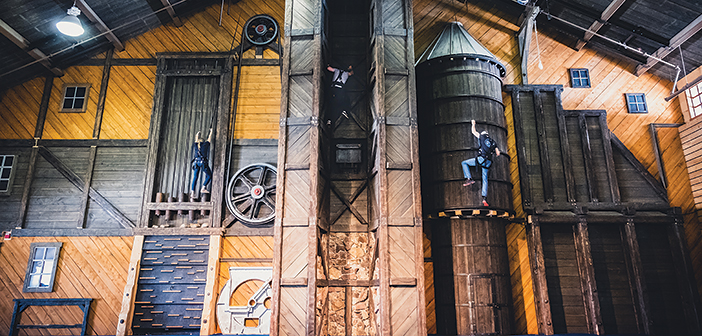
Eldorado Climbing Walls wall at Crooked Creek Ranch in Fraser, Colo.
Wall People
The biggest ongoing concerns for a climbing wall, beyond the initial investments in construction and equipment, are the staff—their hiring, training, and interactions with the guests—and the overall operation of the feature. Key points:
Personable and passionate. As with any other guest-facing position, climbing wall staff need to be personable. “The experience of the guest depends very much on their interactions with operators and staff,” Sotirov says. “You want to hire someone who is passionate about this. If they’re passionate, it’ll show with customers.”
Enhancing the experience. While lean staffing is an operational benefit of climbing walls, for some operators it’s more important to enhance the experience than to operate with minimum staff. At Aspen Snowmass’s Lost Forest, for example, there are three guides for sixty feet of wall, each responsible for his or her section.
These guides, according to Gray, monitor and train guests in the activity. “They’re harnessing people up, they’re introducing them to how to climb,” Gray says. “A lot of time is spent explaining how the auto belay systems work, and that when guests get to the top, they more or less just need to jump off or jump backwards or let go.”
Training. When it comes to training staff, there are third-party opportunities to do so. “In terms of how staff interact with clients,” Frain says, “we recommend that they take a climbing wall instructor course and have the team properly trained for that.” The American Mountain Guides Association offers a climbing-wall instructor certification course, which certifies guides in the professional and safe operation of climbing walls. The course costs up to $350 per guide.
These considerations, and more, factor into deciding to incorporate climbing wall features into a park. Cost, design, maintenance, staffing, operations, and training all require thought into how the feature will flow into the overall design, and what specific purpose it serves the park’s operation.
But for guests? That purpose is just another great adventure at your park.



